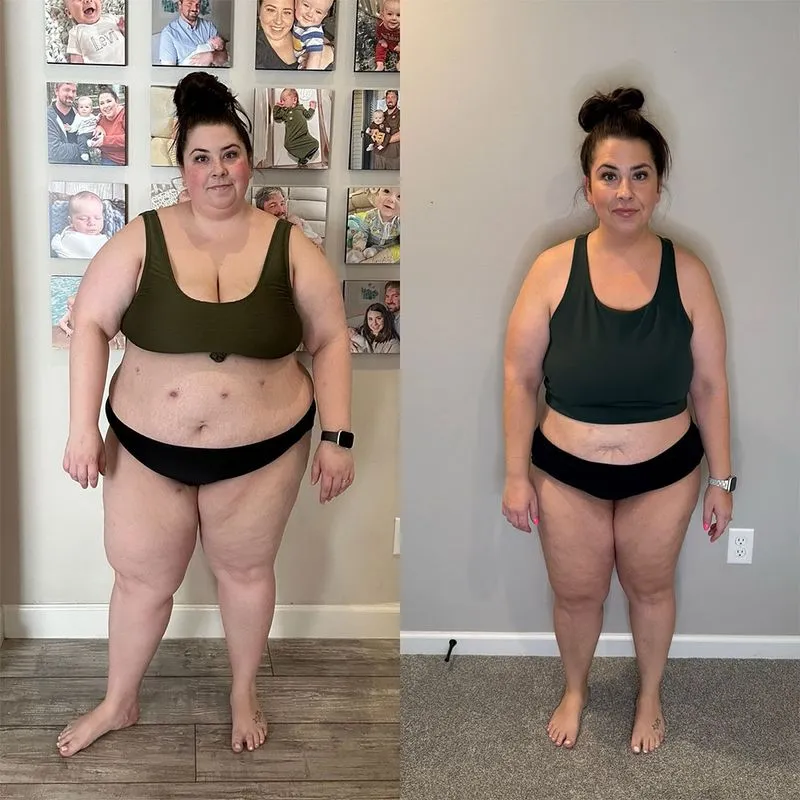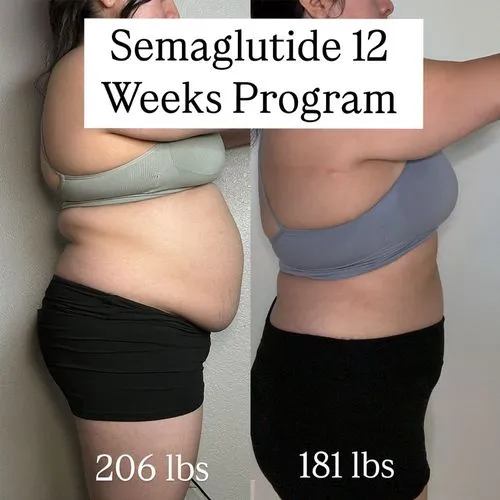
Semaglutide is a medication doctors use to help people lose weight. It has become very popular, and many people are interested in semaglutide before and after photos or real success stories. In this blog, we explain how semaglutide works, what you can expect over time, and the factors that might affect your results. We also explore the Ozempic face effect and why medical aestheticians are paying close attention.
(Disclaimer: This information is for education. We do not encourage or endorse any specific treatment without professional guidance.)
What Is Semaglutide?
Semaglutide belongs to a group of drugs called GLP-1 receptor agonists. According to a study in The New England Journal of Medicine (source), Semaglutide helps the body regulate blood sugar and can slow the digestion process. Often, this results in a smaller appetite. Initially treating type 2 diabetes, doctors originally utilized Semaglutide; many patients also experienced weight loss. During post-marketing studies, it was learned that Semaglutide could aid in weight reduction.
How Semaglutide Works in the Body
Semaglutide functions by replicating the action of a certain hormone called glucagon-like peptide 1 (GLP-1). This hormone makes one feel satiated. It also instructs the pancreas to secrete insulin, which decreases blood sugar levels. Weight loss through reduced calorie intake and controlled blood sugars is possible.
- Reduced Hunger: You feel fuller faster.
- Steady Blood Sugar: Better insulin control often means fewer cravings.
- Slowed Stomach Emptying: Food stays in your Stomach longer, so you may eat smaller portions.
People who use Semaglutide can experience metabolic changes that make weight loss easier to maintain. Clinical trials published in the Journal of the American Medical Association (JAMA) also showed improvements in blood pressure and cholesterol levels in some patients (source).
Semaglutide Before and After: Key Observations
When most people search for Semaglutide before and after 1 month or Semaglutide weight loss before and after, there is a common question in mind. For some, it is two weeks into the cycle when they might start noticing small changes, and for a majority, the primary month is when they look to see significant changes and undergo marked transformations. Here’s what usually happens in those early weeks:
- Reduced appetite
- Mild weight drop
- Better control of cravings
Over time, a lot more change can be seen. Several pieces of data from medical aesthetic professionals showcase the before and after results of patients using Semaglutide by exhibiting Semaglutide pre and post-body composition photographs. As with any weight loss regimen, there is bound to be variability among results depending on the person.

Semaglutide Results in Clinical Trials
People who took part in extensive clinical studies often lost 10 to 15 percent of their body weight over 68 weeks. Some got as high as 20%. But remember that different people can have different results. Weight at the start, diet, activity, and dosage are some of the things that affect the outcome.
Semaglutide Reviews Before and After
Many people online talk about how they've gained energy and lost weight. Some guys have shared "Before and After Semaglutide Men" pictures to show how their belly fat has changed. Others stress how much clothes sizes have shrunk. Even though hearing about other people's inspiring stories can be helpful, relying on facts and medical advice is still essential.

Timeline of Semaglutide Results
Results can happen at different speeds, but here’s a general idea:
Semaglutide Before and After 1 Month
- Appetite Changes: Most people notice they get full sooner.
- 2-5 Pounds Lost (Approx.): It varies, but small weight changes can appear even by week four.
Semaglutide Before and After 6 Weeks
- Increased Weight Loss: More steady pounds dropped as the medication dose may be adjusted.
- Early Metabolic Shifts: Lower fasting blood sugar, improved insulin sensitivity.
A typical search phrase is a semaglutide 6-week belly Olympic weight loss before and after, referring to how belly fat may gradually shrink during this period. Of course, how visible these changes are will also depend on your body type.
Semaglutide Before and After 2 Months
- Fat Reduction: More noticeable around the waist, hips, or thighs.
- Clothes Fitting Better: Many people report dropping one or two clothing sizes.
- Possible Side Effects: Some individuals might have nausea or digestive issues.
Semaglutide Before and After 3 Months
- More Sustainable Results: By now, many see significant progress in appetite control and routine.
- Habits Forming: Regular exercise and balanced meals help maintain the results.
- Face Changes: Some people notice volume changes in the face (often called “Ozempic face”).

Factors That Influence Semaglutide Outcomes
Why do some patients lose more weight than others? Many elements come into play:
- Diet Choices: Balanced meals are still essential to see the best results.
- Exercise Routine: Regular activity helps burn calories and build muscle.
- Genetics: Some people respond better to certain medications due to genetic makeup.
- Dosage and Duration: Doctors may adjust the dose to manage side effects or increase effectiveness.
- Lifestyle Factors: Sleep and stress management can influence how your body responds.
Addressing Ozempic Face and Aesthetic Treatments
One of the pertinent issues that come up in discussion is the before and after changes to semaglutide face, more commonly referred to as Ozempic face. The name describes the volume loss associated with face fat that can occur when a person loses weight quickly. The individual’s skin may be less supple, and the cheeks might look somewhat sunken relative to how fuller they looked before.
Why Does This Happen?
- Rapid Weight Loss: Sudden fat reduction can leave the skin looking loose.
- Age Factor: Mature skin might not bounce back as quickly as younger skin.
Medical aestheticians are keen to learn how to correct or minimize these changes. That’s why there is growing interest in the Ozempic Face Treatment Course. These courses teach how to restore facial volume, use dermal fillers, and take a holistic approach to a patient’s appearance.
Medical Aesthetics Courses and Peptides for Weight Loss
Semaglutide falls under the scope of peptide medications, which means it is part of a bigger family of peptides that are used for weight loss. If you are a professional or just curious, check out the medical aesthetics courses offered to familiarize yourself with the latest techniques. These programs usually teach how to combine lifestyle participation with skincare and healthy use of peptides to yield optimal results.
As far as educating yourself about these therapies is concerned, browse our guide on peptides designed for weight loss. You will learn how they function alongside practical recommendations to maximize benefits and minimize side effects.
Potential Side Effects of Semaglutide
Here's what you need to understand about Semaglutide’s possible side effects:
- Nausea and Vomiting: These are common when treatment begins.
- Diarrhea or Constipation: There may be some associated digestive complications.
- Headaches: Mild headache symptoms may afflict some individuals.
- Low Blood Sugar: Along with insulin or some other medications you may be using.
Verify with a qualified medical supplier, considering your health history, to ensure Semaglutide is an appropriate option. Certain medical issues may pose some additional risk factors.
Conclusion
Semaglutide has powerful results when it comes to weight loss, but it's important to remember that progress differs from person to person. Some changes are visible in 1 month, while for others, it could take about 3 months. Considering its effects, rapid weight loss does lead to what is popularly known as the Ozempic face. This complication is commonly addressed through some form of specialized training like the Ozempic Face Treatment Course offered by HubMed. For those seeking a more comprehensive approach, medical aesthetics courses also teach about using peptides for weight loss. Most outcomes are enhanced and sustained when Semaglutide is taken with proper nutrition, consistent workouts, and professional support.
FAQs
1. How long does it take for semaglutide to show results?
Most people start noticing small changes within 2 to 4 weeks, especially in appetite and energy. Visible weight loss usually begins after the first month.
2. How much weight can you lose in a month with semaglutide?
On average, people may lose 4 to 6 pounds in the first month, depending on their starting weight, lifestyle, and dosage.
3.What should I expect in the first month of taking semaglutide?
As for the most common first month results, people report decreased hunger levels, decreased cravings, and generally needing smaller portion sizes. Mild side effects such as nausea or constipation might develop as well.
4.Is it realistic to lose 30 pounds in 3 months while taking semaglutide?
Although some individuals have achieved this target, it is not common for most people.Losing 30 pounds in 3 months is possible with consistent use, healthy eating, and exercise—but results vary.
Resources and References
- New England Journal of Medicine – Once-Weekly Semaglutide in Adults with Overweight or Obesity
https://www.nejm.org/doi/full/10.1056/NEJMoa2032183 - Journal of the American Medical Association (JAMA) – Semaglutide and Weight Management
https://jamanetwork.com/journals/jamanetworkopen/fullarticle/2796491 - PubMed Central (PMC) – Semaglutide’s Effects on HbA1c, Weight, and Cardiovascular Risk
https://pmc.ncbi.nlm.nih.gov/articles/PMC9288662/#:~:text=Semaglutide%20is%20an%20analogue%20of%20native%20GLP%2D1,(HbA1c)%2C%20body%20weight%2C%20and%20cardiovascular%20risk%20[13]
Disclaimer:
This article is intended for licensed medical professionals. All protocols, dosages, and treatment insights referenced herein are based on published literature. The content is not intended to encourage application, diagnosis, or self-treatment of unlicensed individuals, and should not be used as a substitute for the clinical judgment of a qualified healthcare provider.

